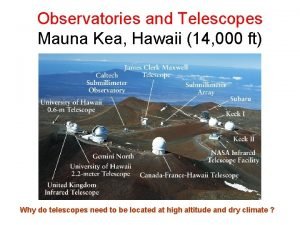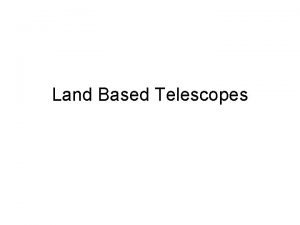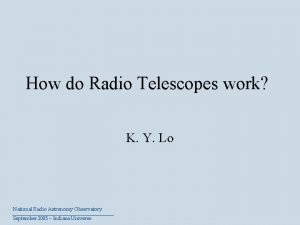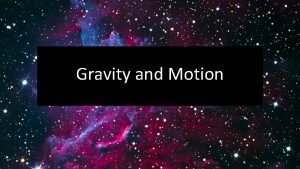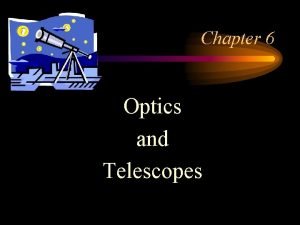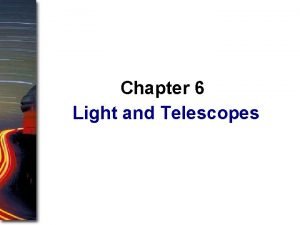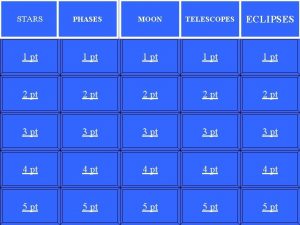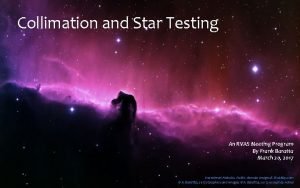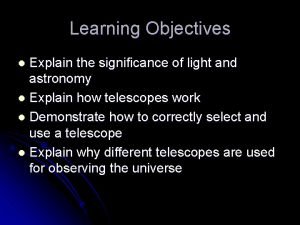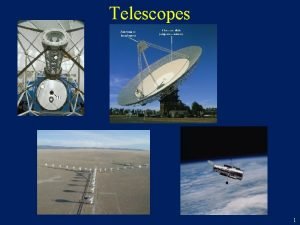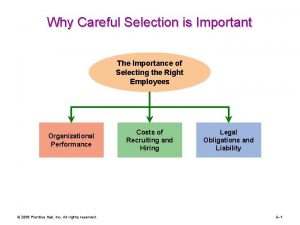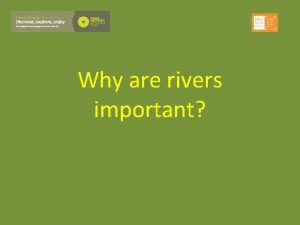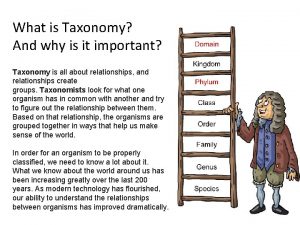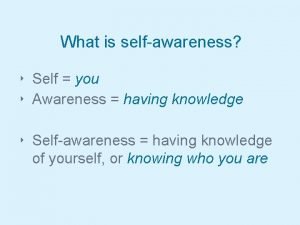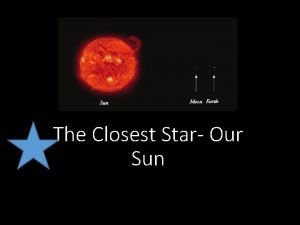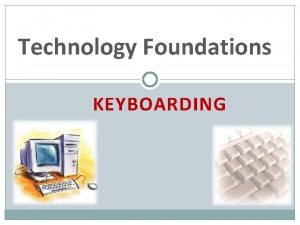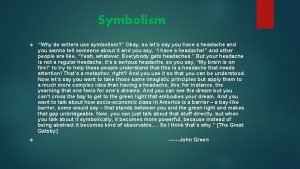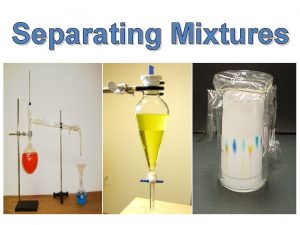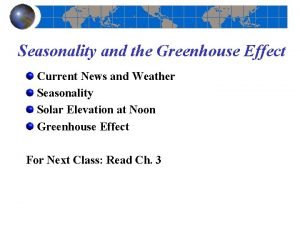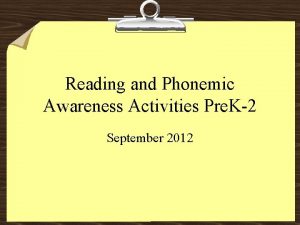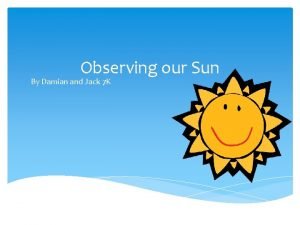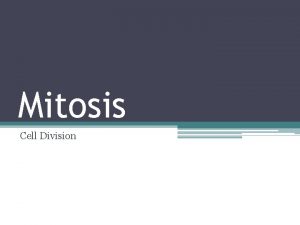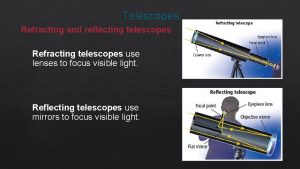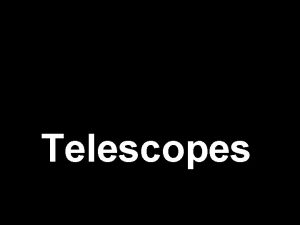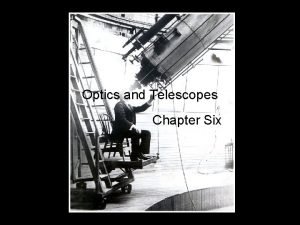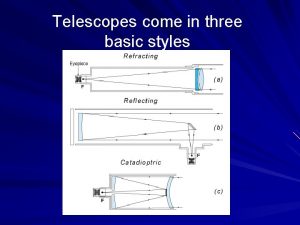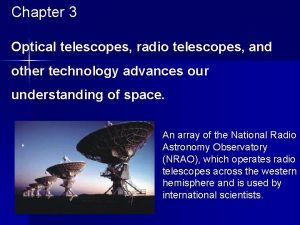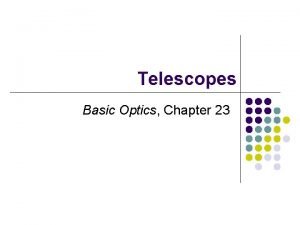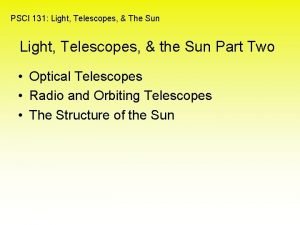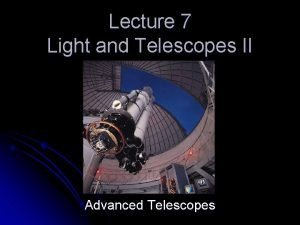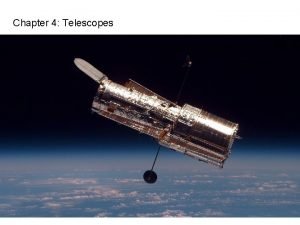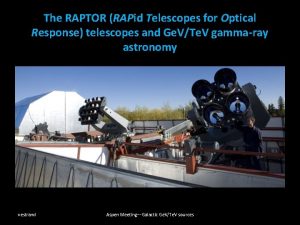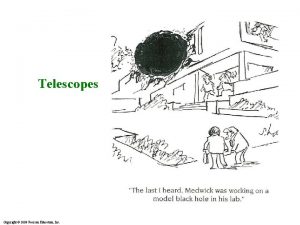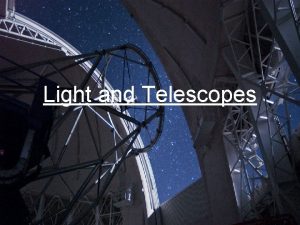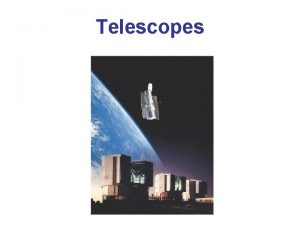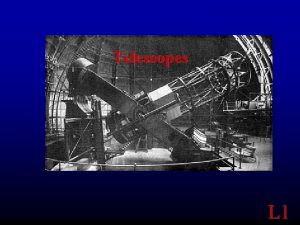Telescopes Why Telescopes are Important n n We





































































- Slides: 69

Telescopes

Why Telescopes are Important n n We spend a lot of time talking about light and images But none of that does us any good if we don’t have a way of collecting that light in the first place q This is where telescopes come in

What is a Telescope? n So just what is a telescope? q An object that uses lenses or reflecting surfaces to collect light from a distant object

The History of the Telescope n n n It is a common misconception that Galileo invented the first telescopes In fact, Hans Lippershey, a Dutch spectacle make, was the first to designing the first telescope(a refractor) Galileo is the first person known to have turned a telescope to the sky (he gets the credit)

Galileo’s Telescope n He was astonished by what he saw q q The rings of Saturn Stars in the Milky Way The moons of Jupiter Spots on the sun n He also went blind-----

Can You Imagine? n Just imagine what he must have felt, being the first person to see these things q q It was all completely unexpected----Galileo’s observations, and those of others, would literally change the course of human history

Telescopes Today n n n Telescopes have come a long way since then The biggest single telescopes have main mirrors that are over 12 meters in diameter! Some telescopes are actually arrays that are made of dozens of smaller telescopes linked together

New telescopes n n Isaac Newton developed the second generation of telescope. He created the reflector telescope that fixed all the problems of the refractor

Largest Gran. Te. Can or GTC 10. 4 m

Tied for 2 nd at 10 m The Hobby-Eberly Telescope or HET Ft. Davis, Texas

Keck 1 & 2 USA , Hi n 10 M

The Giant Magellan Telescope or GMT in 2020 will have 7 -8. 4 m mirrors(24. 5 m)


Today, there are telescopes that are designed to see radio, microwave, infrared, visible, ultraviolet, x-ray and gamma-ray light? 1. 2. True False

How Telescopes Work n There are two main types of telescopes q q q Refracting telescopes use lenses to focus light to a point Reflecting telescopes use mirrors to focus the light Catadioptric telescopes are a combination of the two

Refracting and Reflecting Telescopes

Anatomy of a Telescope n Although there are many types of telescopes, all have some basic key parts

Anatomy of a Telescope 1. 2. 3. 4. 5. 6. 7. Aperture Primary Secondary Eyepiece Optical Tube Finder Detector

Anatomy of a Telescope n n n The aperture is simply the part of the telescope that lets light in The primary bends the light, bringing the rays to a point The secondary aids in this process(changes the direction of the light)

Anatomy of a Telescope n n n The optical tube protects the rest of the telescope and blocks stray rays of light The finder is a small telescope used for honing in on objects The detector is the thing that actually records the light q Could be your eye

Focusing Light n The idea of focusing light is important q q n n Telescopes collect light from a large area By focusing the light, we concentrate its power The focal plane is the plane where the light rays meet The focal length is the distance from the primary lens (or mirror) to the focal plane

Focusing Light

Focusing Light

The Focal Plane n n n If we put our eye at the focal plane, we would only see a bright point The eye piece straightens out the rays of light so our eye can see the image If we move the eyepiece out of the focal plane, the image will be distorted

Common Reflectors

Some Other Telescope Properties There are some other properties of telescopes that astronomers are interested in Some of these things are(in order) n n 1. 2. 3. 4. Collecting Area Resolution Magnification Cost

What is the most important property of a telescope for astronomers? 1. 2. 3. Magnification Collecting Area Focal Length

Collecting Area n Collecting area is the area of the surface that the telescope uses to collect light q n This is usually the primary lens or mirror Many people think that magnification is the most important property of a telescope, but it is actually collecting area

Collecting Area n Why is collecting area important? q q q Suppose you are trying to see a very faint source If it is faint, then it is not sending many photons to Earth We need to collect as many photons as we can Having a large collecting area does this – like casting a big net to catch more fish Astronomers like to call telescopes “Light Buckets”

Collecting Area n Most astronomical objects are pretty faint, so we need to collect as much light as we can

Resolution n n The resolution of a telescope defines how much detail we can see All optical systems have some resolution limit q Eventually, the separation between objects becomes too small for us to see

Angular Size n We measure the separation of objects in terms of angles q q q Remember that there are 360° in a full circle There are 60 arc minutes in a degree, and 60 arc seconds in an arc minute So there are 3600 arc seconds for every degree of sky.


Back To Resolution n Consider looking at a distant mountain q q Although the mountain is covered in trees, we cannot make out the trees themselves Our eyes have too low of a resolution

Telescope Resolution n n Telescopes have a much improved resolution, but there is a limit The resolving power of a telescope (with a round primary) cannot be greater than Copy this formula! n n R will be in radians (1 radian = 57. 3 degrees) L = wavelength and D = Diameter of mirror q Both L and D must be the same unit!

Telescope Resolution n n Notice that this depends on both wavelength and the diameter of a telescope This is a natural limit…it is set by nature and we simply cannot do better

Telescope Resolution n Other things affect the resolution of a telescope q q n Atmospheric distortions are notoriously bad Think of the “waves” that come off of hot asphalt But there are things we can do to compensate for these effects

Telescopes in Space n n The most straightforward is to put our telescope above the atmosphere There is another good reason for doing his, and it has to do with how light travels through the atmosphere

Atmospheric Transparency

Why Do We See What We See? n 1. 2. 3. This provides a great explanation of why our eyes are sensitive to visible light The Sun puts out most of its light in the visible part of the spectrum Only visible light and radio make it through the atmosphere Radio waves have very long wavelength, so we would need very big eyes to resolve anything

Magnification n Astronomer’s do like magnification, too q q But note that it does not matter how much you magnify something…if you cannot resolve it, magnification does you no good Think of a pixelated image

Pixelation

Magnification n With that in mind, here is the jist on magnification q q Magnification is defined as the increase in angular size The formula to calculate magnification is n f. T is the focal length of the telescope n f. E is the focal length of the eyepiece

What will give you a larger magnification? 1. 2. A short eyepiece focal length A long eyepiece focal length

Magnification n A longer focal length for the telescope, or shorter focal length for the eyepiece, means a larger magnification

Cost n n n Cost is of course a practical concern, but it needs to be taken into account Telescopes can cost as much as hundreds of millions of dollars, and guess who pays for most of it… Space telescopes are especially expensive, so we need to make compromises

Nickels and Dimes… n Since it costs lots of money to put a telescope in space, space telescopes are usually smaller q n No atmosphere, but less collecting area, =lower limiting resolution There also lots of practical concerns

Precision Instruments n n If astronomers want the best possible data, their telescopes have to be very, very good Consider that in order to get a clear image, your mirrors or lenses need to be perfect on scales of about the wavelength of light you are looking at q This can be nanometers

Some Famous Telescopes

Some Famous Telescopes

Some Famous Telescopes

Some Famous Telescopes

Detectors n n n So, we collected all our light…now what? It doesn’t do us any good if we can’t see the light Of course, we always have our eyes, but…

Do you think that you would ever see an image like this one if you looked through a telescope using only your eyes? 1. Yes 2. No 0 of 5

Sorry n n I hate to tell you, but the answer is definitely no Why not? q q Well, remember, most things we look at through a telescope are really faint Even though we collect more photons with telescopes, we need to collect them for long periods of time to make images like those

More Reasons Your Eyes Aren’t Good n n Our eyes are also only sensitive to visible light They are subjective tools They can not store images long term They are horribly inefficient

STOP

CCDs n n n CCDs revolutionized astronomy again CCD stands for charged coupled device This is the same technology at use in digital cameras

CCDs

CCDs n CCDs are great because q q They are very efficient They allow you to take digital data…analyze on computer They have a linear response They have a wide dynamic range

CCDs n n CCDs are by far the most common detector in astronomy Although some others exist, it is not worth talking about them here

Spectrographs n n n We don’t always want to make an image Sometimes, we want to split the light into its spectrum We use spectrographs for this

Spectrographs n There are two basic types of spectrographs q q n Prisms Gratings Combining the two, we get Grisms

Prisms

Prisms n n Prisms work because light of different wavelengths takes a slightly different path Comes out at a different place, and is thus spread out

Gratings

Gratings n n Gratings are made up of hundreds or thousands of tiny grooves They use a phenomenon of light known as diffraction to split the light

Grisms n n Grisms use both effects Gratings and grisms are the most commonly used spectrographs in astronomy

Spectrographs n n Once we split the light by wavelength, we usually use a specially designed CCD to actually measure the photons Since we splitting the light up and smearing it, spectroscopy needs lots of photons, i. e. a bright source
 Mikael ferm
Mikael ferm Pictures
Pictures Dont ask why why why
Dont ask why why why Newspaper article format
Newspaper article format Inverted pyramid in news writing
Inverted pyramid in news writing Least important to most important
Least important to most important A building that contains one or more telescopes
A building that contains one or more telescopes Chromatic aberration affects reflector telescopes.
Chromatic aberration affects reflector telescopes. Land based telescopes
Land based telescopes Computer controlled telescopes
Computer controlled telescopes How do radio telescopes work
How do radio telescopes work Modern telescopes make it possible for astronomers
Modern telescopes make it possible for astronomers All modern large optical telescopes are refractors.
All modern large optical telescopes are refractors. The design of modern x-ray telescopes depends on
The design of modern x-ray telescopes depends on New moon telescopes
New moon telescopes Star collimation
Star collimation Timeline of telescope
Timeline of telescope Refracting telescopes exhibit great focus and color.
Refracting telescopes exhibit great focus and color. Structure of radio telescope
Structure of radio telescope Crucifixion quotes gcse
Crucifixion quotes gcse Footwork rule in netball
Footwork rule in netball Why is communication important in the workplace
Why is communication important in the workplace Why experience is important
Why experience is important Why strategic planning is important to all managers.
Why strategic planning is important to all managers. Why is water important to living things
Why is water important to living things Why is reading important
Why is reading important What is physical diversity in geography
What is physical diversity in geography Why careful selection is important
Why careful selection is important Why are rivers important
Why are rivers important Dumbking plant
Dumbking plant What is selfawareness
What is selfawareness What is the passover
What is the passover Vad är advent
Vad är advent Things we should do in ramadan
Things we should do in ramadan Why are wetlands important
Why are wetlands important Managerial judgement method
Managerial judgement method Uml 0..*
Uml 0..* Tolerance is important
Tolerance is important Why is time management important
Why is time management important We need quality food justify
We need quality food justify Why is culture important
Why is culture important The importance of compliments
The importance of compliments 3 health triangle
3 health triangle Why is genetic diversity important
Why is genetic diversity important Importance of the sun
Importance of the sun Why is keyboarding important
Why is keyboarding important Kingdom genus species family class order
Kingdom genus species family class order Important of symbols
Important of symbols One of the toughest parts of summarizing is
One of the toughest parts of summarizing is Organic social media
Organic social media Cultural identity
Cultural identity Filtration examples in everyday life
Filtration examples in everyday life Why is the greenhouse effect important
Why is the greenhouse effect important Angular momentum
Angular momentum Why break-even point is important
Why break-even point is important What is fermentation
What is fermentation Five refusal skills
Five refusal skills Phoneme addition activities
Phoneme addition activities Why is sawm important
Why is sawm important Punctuation is important
Punctuation is important Why is feedback important
Why is feedback important Why is cellular respiration important
Why is cellular respiration important Julia lane coleridge
Julia lane coleridge Onomatopoeia sound device examples
Onomatopoeia sound device examples Why is performance management important?
Why is performance management important? Parallelism definition
Parallelism definition Types of eclipses
Types of eclipses Why building community is important
Why building community is important Ignorance
Ignorance Interphase of cell cycle
Interphase of cell cycle







